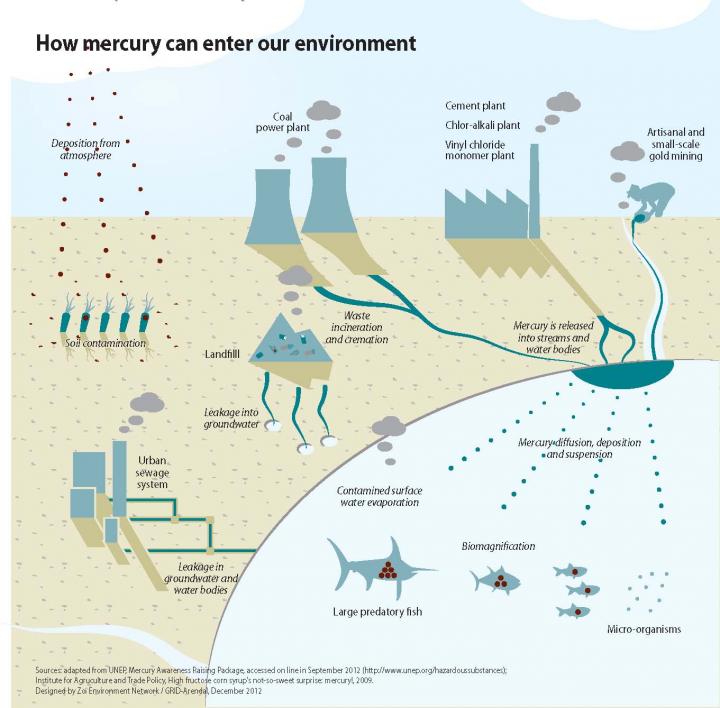Researchers develop new instrument to monitor atmospheric mercury

This graphic shows how mercury can enter the environment. Credit: UNEP Chemicals Branch, DTIE - Switzerland
Researchers at the University of Miami (UM) Rosenstiel School of Marine and Atmospheric Science developed and tested a new sensor to detect ambient levels of mercury in the atmosphere. Funded through a National Science Foundation Major Research Instrumentation grant, the new highly sensitive, laser-based instrument provides scientists with a method to more accurately measure global human exposure to mercury.
The measurement approach is called sequential two-photon laser induced fluorescence (2P-LIF) and uses two different laser beams to excite mercury atoms and monitor blue shifted atomic fluorescence. UM Rosenstiel School Professor of Atmospheric Sciences Anthony Hynes and colleagues tested the new mobile instrument, alongside the standard instrumentation that is currently used to monitor atmospheric mercury concentrations, during the three-week Reno Atmospheric Mercury Intercomparison Experiment (RAMIX) performed in 2011 in Reno, Nevada.
The 2P-LIF instrument measured ambient mercury at very minute levels within 10 seconds, whereas its counterpart instrument requires at least 2.5 minutes and is not able to differentiate between elemental and oxidized mercury, where the mercury atom is combined with another element or elements and becomes more efficiently deposited in the environment.
“To understand how mercury gets deposited we need to understand its atmospheric chemistry, but our understanding is very limited,” said Hynes, a co-author of the new study. “Our instrument has the potential to greatly enhance our understanding of the atmospheric cycling of mercury and increase understanding of the global impact of mercury on human health.”
The U.S. EPA Mercury and Air Toxics Standards and the International Minamata Convention on Mercury, have focused on limiting the emissions of toxic air pollutants, including mercury. Hynes noted that these represent huge steps forward but their effectiveness in protecting human health may be limited without an increased understanding of the global cycling of atmospheric mercury.
Mercury is deposited on the ground (dry deposition) or via rainfall (wet deposition) where it bioaccumulates and biomagnifies, ending up at much high concentrations in fish and mammals. Direct exposure to mercury by humans is primarily through the ingestion of methyl mercury from fish consumption.
###
The study, titled “Deployment of a sequential two-photon laser-induced fluorescence sensor for the detection of gaseous elemental mercury at ambient levels: fast, specific, ultrasensitive detection with parts-per-quadrillion sensitivity,” was published in the Dec. 8 issue of the journal Atmospheric Measurement Techniques. The study co-authors include: Anthony J. Hynes, Dieter Bauer, James Remeika, Stephanie Everhart, Cheryl Tatum Ernest of the UM Rosenstiel School of Marine and Atmospheric Science's Department of Atmospheric Sciences. The Instrument development was supported by NSF Award #MRI-0821174.
About the University of Miami's Rosenstiel School
The University of Miami is one of the largest private research institutions in the southeastern United States. The University's mission is to provide quality education, attract and retain outstanding students, support the faculty and their research, and build an endowment for University initiatives. Founded in the 1940's, the Rosenstiel School of Marine & Atmospheric Science has grown into one of the world's premier marine and atmospheric research institutions. Offering dynamic interdisciplinary academics, the Rosenstiel School is dedicated to helping communities to better understand the planet, participating in the establishment of environmental policies, and aiding in the improvement of society and quality of life. For more information, visit: http://www.
Media Contact
All latest news from the category: Earth Sciences
Earth Sciences (also referred to as Geosciences), which deals with basic issues surrounding our planet, plays a vital role in the area of energy and raw materials supply.
Earth Sciences comprises subjects such as geology, geography, geological informatics, paleontology, mineralogy, petrography, crystallography, geophysics, geodesy, glaciology, cartography, photogrammetry, meteorology and seismology, early-warning systems, earthquake research and polar research.
Newest articles

A ‘language’ for ML models to predict nanopore properties
A large number of 2D materials like graphene can have nanopores – small holes formed by missing atoms through which foreign substances can pass. The properties of these nanopores dictate many…

Clinically validated, wearable ultrasound patch
… for continuous blood pressure monitoring. A team of researchers at the University of California San Diego has developed a new and improved wearable ultrasound patch for continuous and noninvasive…

A new puzzle piece for string theory research
Dr. Ksenia Fedosova from the Cluster of Excellence Mathematics Münster, along with an international research team, has proven a conjecture in string theory that physicists had proposed regarding certain equations….



